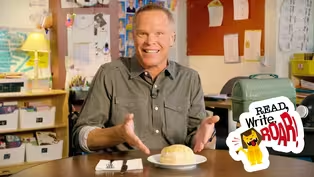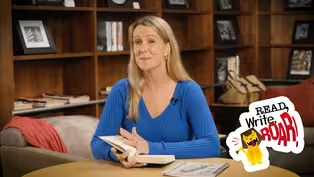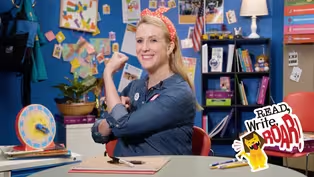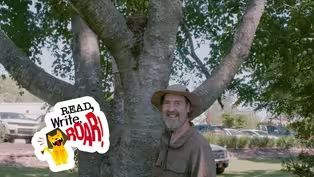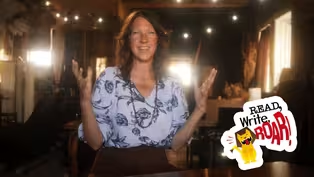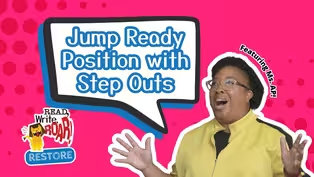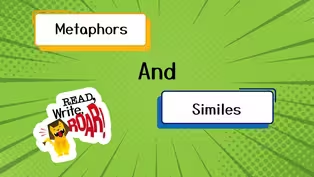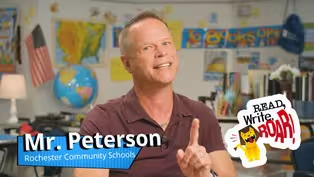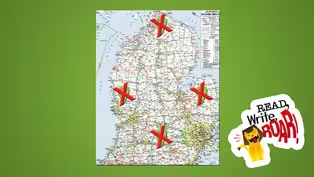Read, Write, ROAR!
Making Michigan - Lessons in Michigan History
Season 1 Episode 1002 | 26m 45sVideo has Closed Captions
Take a dive into the history of Michigan.
Take a dive into the history of Michigan. First, learn about how Lansing became Michigan's capital city. Then, take a look at how Toledo ended up in Ohio!
Problems playing video? | Closed Captioning Feedback
Problems playing video? | Closed Captioning Feedback
Read, Write, ROAR! is a local public television program presented by Detroit PBS
Read, Write, ROAR!
Making Michigan - Lessons in Michigan History
Season 1 Episode 1002 | 26m 45sVideo has Closed Captions
Take a dive into the history of Michigan. First, learn about how Lansing became Michigan's capital city. Then, take a look at how Toledo ended up in Ohio!
Problems playing video? | Closed Captioning Feedback
How to Watch Read, Write, ROAR!
Read, Write, ROAR! is available to stream on pbs.org and the free PBS App, available on iPhone, Apple TV, Android TV, Android smartphones, Amazon Fire TV, Amazon Fire Tablet, Roku, Samsung Smart TV, and Vizio.
Providing Support for PBS.org
Learn Moreabout PBS online sponsorshipMore from This Collection
Learn the literacy skills every 4th and 5th grader needs while exploring what makes Michigan unique.
Tasty Michigan Treats - Michigan's Unique Foods and Snacks
Video has Closed Captions
Learn about Michigan's magical foods! (26m 45s)
Let's Talk Together - Michigan's Languages
Video has Closed Captions
Learn all about languages you might hear in Michigan! (26m 46s)
What's Up With the Weather? - Michigan's Climate
Video has Closed Captions
Learn all about Michigan's climate. (26m 46s)
Video has Closed Captions
Learn how to use multiple sources and how narrative text works! (26m 46s)
Providing Support for PBS.org
Learn Moreabout PBS online sponsorship- Hey, learners.
Welcome to "Read, Write, Roar".
We're taking a look at some of Michigan's key moments.
We'll also learn how to read a timeline and how to make our writing roar by using figurative language like metaphors and similes.
Let's go "Read, Write, Roar".
- [Narrator] This program is made possible in part by the State of Michigan and by and by viewers like you.
Thank you.
(upbeat music) - Hmm.
The capital of Michigan not in Lansing?
It's always been there, hasn't it?
Oh, hi, I'm Mrs.
Mask, and today, we're going to learn about how Michigan State Capitol ended up in Lansing, and where it was located before Lansing, Detroit.
Then we'll take what we learned and write an opinion letter.
An opinion letter gives thoughts about why something is a good or bad idea.
Before we get started with the history lesson, let's look at the word Capital.
When it spells with an A, it means a few different things, but today the meaning we're going to discuss is connected to the seat of government.
The seat of government is the main place where leaders of a country, state, or city work and make important decisions.
Now let's look at the word Capitol spelled with an O.
This spelling means the actual building that holds our government, and Michigan's capitol building is beautiful.
Once Michigan became a state on January 26, 1837, people thought Detroit would be a good idea, but why?
Their reasons, Detroit seemed like a good choice.
It was next to the Detroit River, so getting to the Great Lakes was pretty easy.
It was close to Canada so businesses could quickly get things across the border for trade.
The land in Detroit was cheap and easy to acquire for farming, housing, and businesses.
Even with all of these reasons to have Detroit as the capital.
In 1848, the decision was made to move it.
Legislators, the people who make laws, again, had to make a choice of where the capital should be.
Some of the suggestions at the time were Ann Arbor, Jackson, Grand Rapids, Shiawassee Township, and Marshall.
Lansing Township was not even on the list in the beginning, so how'd the capital end up there?
The proposal to make Lansing Township the capital was made by state Senator Joseph H Kilborn of Meridian Township, Ingham County.
It was a compromise to end anymore disagreements about where the new capital should be.
A compromise is when both sides give up something so they can settle a disagreement.
Since Lansing Township wasn't too far north, too far south, too far west or Eastern Michigan, but instead in the middle, it seemed like a good compromise.
Eventually the House in Senate approved the proposal to have Lansing Township become the new capital.
It then became named the Town of Michigan before it finally became the city of Lansing, which is still its name today.
Now let's go back in time a bit and imagine we are a state legislator that supports Senator Kilborn's idea of moving the capital from Detroit to Lansing.
By seeing history through the point of view of someone living during that time, we will better understand the events.
The purpose of writing a letter to the legislature is to share our opinion that Lansing Township should become the capital.
So now we have a purpose and an audience.
Let's get started.
Michigan legislature, 1 Capital Square, Detroit, Michigan.
July 19th, 1842.
Dear Legislature, I understand that there is discussion about moving the capital of our state away from Detroit.
I agree with this idea and want to share information about why Lansing Township is a good location.
Let me tell you more.
When Detroit was chosen as a location for our first capital, it seemed ideal.
However, the reasons why Detroit was originally chosen as our capital are the same reasons why Detroit is no longer a good idea.
Although situated on the Detroit River, it's giving easy access to our Great Lakes in Canada.
Detroit is in fact too close to Canada, making it an easy target for the British who are there.
Detroit is also too far east in Michigan, making it very difficult to get to for those living in the north and west.
We need our residents to be able to get to our capital easily since it is the center of our state government.
And when I think of the center of our state, I think of Lansing Township.
There is no better place to have the center of our government, our capital located.
Lansing Township is easy to get to from anywhere in the Lower Peninsula.
It's away from any of the borders, so a threat of conflict with other countries would be minimal.
Lansing Township has natural waterways like rivers that can be accessed from other areas in Michigan.
I urge you to join me in support of moving the capital to Lansing Township.
Our capital will bring visitors and businesses to the middle of the state.
It's a very safe location and it's easy to get to from all areas of our state, and has waterways to support trade.
Please support me as I support Lansing Township as our new capital.
Your Fellow Legislature, Miss LaDonna Mask and the Read, Write, and Roar learners.
That's you.
Hmm, do you think our letter supports our opinion well?
If you were a legislator, would you be persuaded to share my opinion?
What's something you have a very strong opinion about?
Do some research and plan out the important points you will share to better inform others.
Good luck.
(upbeat music) (bright music) - I'm Ms. AP, here to help restore your energy.
Let's start with our warmup.
We are gonna be running in place by the count of 10.
Ready?
Go.
1, 2, 3, 4, 5, 6, 7, 8, 9, 10.
Good job, everyone.
Now that we've warmed up our bodies, we are ready to exercise.
Today, we're gonna be working on moving our legs from one side to the other.
To get ready, let's stand in our ready position.
Remember tall like a pencil, arms down, legs together.
Once my body is in that ready position, we are gonna step out with one foot, then bring it back, switch sides.
Now the other foot, and bring it back.
Again, out and back.
Switch out and back.
Good.
Now let's try that 30 more times.
Ready, go.
One, two, three, four, five, six, seven, eight, nine, 10.
Out, back, out, back, out and in.
Out, in.
20, 21, 22, 23, 24, 25, 26, 27, 28, 29, 30.
Give yourselves a big clap, clap.
(clap loudly) Wow, nice job.
Let's start cool down.
Breathe in, we breathe out.
Breathe in and breathe out.
Great job.
(upbeat music) - Hi, I'm naturalist Paul Roose.
We are heading outdoors to appreciate Michigan birds, and that reading and writing is everywhere.
Even though we may not see a bird, we can use our powers of observation to infer that birds are present and possibly nesting in an area.
Have you ever thought about how scientists research and gather information about birds?
The more we understand about a species, the more we can conserve and protect them.
There are also people who are nature data detectives.
These citizens are regular people like you and me and can gather information that can be used by scientists.
Since scientists can't be everywhere and see everything all the time, they rely on the eyes and ears of citizens all over the world to collect data.
These citizens are called citizen or community scientists.
Today, we're going to practice becoming a citizen scientist.
Not only will we record what we see, but we're going to practice reading and writing information in charts and graphs.
So grab something to write with and a piece of paper, and let's get started.
First, I'd like to show you an example of written observations I have previously made by birdwatching in my yard.
As you can see, my handwriting is messy.
If I wanna share this information with others, I put it in a format that can more easily be understood and read, a graph.
Graphs are filled with data and are different type of texts from which we can get information.
I have taken my notes and made a graph that summarizes the number of individual birds of different species I have seen in my yard.
Together, let's read the graph I made.
I've recorded five of the species in the graph.
What kind of bird did we see most often?
The house sparrow.
Are you ready to become a citizen scientist and record some observational data with me?
Let's head over to my bird house, which has a house sparrow nest in it.
This is a special bird house that allows me to safely open it up to see inside.
Let's get our journals and start our work by writing down some questions together to guide our research.
Be sure to leave some space for writing after each question.
We are going to check in to our nest over the next several weeks.
Each time we check in, we're going to create a hypothesis in response to each question.
Then we'll record our observations.
Our first question is, how many eggs will be laid?
I know from reading that most backyard birds lay three to five eggs.
What is your hypothesis?
My guess is four eggs will be laid this year.
Look, we have four eggs.
Now my next question is, how many eggs will hatch?
I think four eggs will hatch.
Let's check back in about a week.
Now let's carefully look inside.
We have four baby birds.
Another word for a baby bird is a nestling.
(bird chirping) Let's record our data and write down our next question and hypothesis.
How many birds will successfully leave the nest?
My hypothesis is four baby birds will leave the nest.
Now, it's been about two weeks since we first observed the house sparrow nest in the bird house.
The outcome is what happens to the nestlings.
The only way to know for sure is to see it.
So if we open the bird house and all the nestlings are gone, we can infer that they left the nest.
What is the outcome of the nest?
Look, there are no baby birds in the nest.
Sometimes nestlings can be eaten by a cat or another predator, but looking around I can infer that the nestlings flew away.
Thanks for helping me read and write about the nest.
(bird chirping) If you want to learn more about citizen and community science, a great place to start is by asking your teacher or local librarian for more information, and then you can get started in your own backyard or neighborhood as a nature data detective.
(upbeat music) - Have you ever wondered why Michigan and Ohio often seem to clash?
Maybe it's our college football teams.
Maybe it's because Michigan has Motown, in Ohio, has the Rock and Roll Hall of Fame.
Or maybe it started way back with the Toledo War in 1835.
Although the historical name is the Toledo War, it was really more of a disagreement or conflict.
I'm Mr. Peterson, and today, we're going to learn a bit of history around this conflict.
As we explore the history of this disagreement, we will be using a timeline of important events.
Timelines help us as readers and writers keep track of the order or sequence in which events happen, and also help us more easily find answers to questions we have about the topic of the timeline.
The Toledo War was a conflict between Ohio and Michigan over a piece of land called the Toledo Strip.
Both sides wanted it because Toledo was a great place for trade, especially with its access to Lake Erie.
But there's a little bit of information we need on our timeline before we get to the actual conflict.
Timelines can look many different ways.
Timelines usually run from left to right or horizontally, and some run top to bottom or vertically.
We'll be reading a vertical timeline today.
Let's take a look.
This timeline starts with 1787.
The Northwest Ordinance created a system for settling new territories in the area, including what is now Ohio and Michigan.
Early 1800s, both Ohio and Michigan were developing areas.
1803, Ohio becomes a state in the United States.
I think it's important to know that Ohio became a state before Michigan, because when Ohio became a state, there was some confusion about its northern borders.
While Michigan was not officially a state yet, in 1805, the Michigan territory was created.
A territory is part of a country that is not a state.
Today, the United States still has territories like Puerto Rico.
1818, the border disputes started to get more serious because both Ohio and Michigan claimed the Toledo Strip, a narrow piece of land along their border.
Land surveys showed different things for the territory of Michigan and Ohio state borders.
They just didn't match and both believed that the Toledo Strip belonged to them.
1835, Michigan sought to become a state, but Congress asked them to resolve the border dispute first.
So before Michigan could become a state, the dispute with Toledo would need to be settled.
The conflict reached its peak and both Ohio and Michigan sent soldiers to this Toledo Strip.
There were a few small fights but no major battles.
Also, in 1835, the following happened.
Surveyors arrested at the Toledo Strip.
Michigan Governor, Stevens T. Mason, sent people that determined boundary lines known as surveyors to the Toledo Strip.
Ohio's militia arrested them, which added even more attention to the fight.
1836, Congress proposed a compromise to end the dispute between the territory of Michigan and the State of Ohio.
Based on what we know from this and what we know now, what do you think the compromise was?
Well, a compromise is when both sides give up something so they can settle a disagreement.
Congress proposed that Ohio take the Toledo Strip and in return, Michigan would become a state and also get the entire Upper Peninsula, which turned out to be rich in resources.
1837, Michigan becomes a state.
In present day, Michigan and Ohio have friendly sport rivalries, but long gone are any border disputes.
Timelines not only help us keep events organized, but they also help us more quickly access answers to questions that are related to those events.
Let's practice a couple together.
Question.
How many years was Michigan a territory before it became a state?
Well, Michigan became a state in 1837 and was a territory created in 1805.
So I'll count backwards or subtract years starting in 1837 and ending in 1805.
I know the answer is 32 years.
I was able to do that quickly because the information is very easy to find on a timeline.
Question.
Who proposed a compromise that would end the conflict between Michigan and Toledo, and when was it?
I can do a quick scan for the word compromise on the timeline.
Oh, I see it.
Yep, 1836.
And when I read the description on the timeline, I can see that Congress is who proposed the compromise.
Finding answers on a timeline is pretty easy.
Everything is in order and lots of information is given with only a few words.
By looking closely at the order or sequence in which things happen, we can understand events and occurrences in the world better.
Not only did we learn how the Upper Peninsula or UP became part of Michigan, but we also learned the value in using visuals like timelines.
Try using the timeline we built today to teach a friend or a family member a bit of important Michigan history and share the journey of how the UP became a part of our state with the power of compromise.
(upbeat music) - Hello, my name is Ms. Audra, and today, we are gonna create a soundscape, a soundscape of the city, right?
So I want you to think about all the different sounds you might hear in your city.
While we think about that, I want you to take a deep breath in, and just hold it here and then blow it out like the wind or the ocean if you want.
Any sound you want.
And as we breathe in this time, bring calm and steady.
Here we go.
And hold and blow it out.
All right.
So the sounds of the city, horns beeping, beep-beep.
Something chiseling into the cement, chu-chu-chu.
A little bird flying around.
The sound of the wind may be through the leaves.
Metal sign on a fence.
Bring something into your mind.
And as you do, think about a hand movement.
It could be your hand, your arm, or your full body if you have enough space where you are.
So as a group, we're gonna do it all together at the same time.
And I'm gonna listen and I'm gonna add too.
On the count of three, are you ready?
1, 2, 3.
Yeah, keep it up, keep it up.
See if you can look and listen to others in the room.
And I'll add my sound too.
(whistling loudly) And 1, 2, 3, pause.
Nice.
Think about all the different sounds.
Think about the beautiful soundscape that we created together and the movement that you made for your sound today.
(upbeat music) - What is the paint brush that adds color to our writing, and what makes our writing delicious like ice cream?
Well, it's metaphors and similes, of course.
And that is what we're going to learn today.
(bright music) That language makes our writing more colorful and interesting.
Sure, you can say, "It's raining a lot."
But it's way more fun to say, "It's raining cats and dogs."
It's fun to imagine cats and dogs falling from the sky like rain.
But we know that's not possible, unless... Figurative language is the Parmesan cheese on top of your pasta, but for reading and writing adds a lot of flavor.
And who doesn't love Parmesan cheese?
(bright music) We'll look at examples such as similes, which compare things using like or as, and metaphors, which say something is another thing.
(bright music) Hi, I am Miss Meg, and I live in Kalamazoo.
It's on the west side of the state, close to Lake Michigan.
It's also halfway between Detroit and Chicago.
Cool, right?
One thing I love about my city is that there's always something fun to do.
Like going to visit one of the different museums or trying out a new restaurant.
There's also tons of local events like the Chili Cook-off or the Christmas Tree Lighting Ceremony at Bronson Park.
As you can imagine, Kalamazoo is a bustling beehive of excitement.
That's a metaphor.
Think about the bees that work together in well.
But Kalamazoo is like that too.
Everyone works together to make the community fun.
So even though Kalamazoo isn't actually a beehive, you can see how the two aren't so different from each other.
Now visiting Kalamazoo is like a treasure hunt with hidden gems of fun waiting to be discovered around every corner.
That's a simile.
I'm using the word like to compare visiting Kalamazoo to a treasure hunt.
There's always something new to try and history to learn.
(bright music) Speaking of trying something new, let's play a game I like to call simile or metaphor.
(bright music) "Sweet as Mackinac Fudge."
Simile or metaphor?
(bright music) Simile.
Great job.
Now let's try this sentence.
"Michigan is a playground of fun to discover."
Simile or metaphor?
(bright music) Metaphor.
Great job.
(bright music) Let's take a look at our last sentence.
"The Great Lakes of Michigan shimmer like glitter."
Simile or metaphor?
(bright music) Simile.
Great job.
(bright music) So let's break it down.
Similes use the words like or as to compare the city of Kalamazoo to a treasure hunt, and metaphors take the State of Michigan and compare it to a playground.
Both of these things make us excited.
I mean, who doesn't love a playground and a treasure hunt.
That's all for today.
But don't worry, learning something new is just the first chapter in a book.
There's always more to read.
You're like an astronaut in space, exploring new discoveries left and right.
Keep exploring the different ways to have fun with writing.
See you soon.
- Thank you for watching.
For more episodes, videos, lessons, activity guides and more, be sure to visit us at our website.
And don't forget, "Read, Write, Roar".
(upbeat music) (upbeat music continues) (upbeat music continues) (upbeat music continues) (upbeat music continues) - [Narrator] This program is made possible in part by the State of Michigan, and by and by viewers like you.
Thank you.
(upbeat music) (upbeat music continues) (upbeat music continues) (gentle music)
Become a Citizen Scientist: Birdwatching Data Collection | Paul Roose | Read, Write, ROAR!
Video has Closed Captions
Clip: S1 Ep1002 | 4m 30s | Be a citizen scientist with Paul Roose! Learn to observe, collect, and record data. (4m 30s)
Create a City Soundscape | Ms. Audra | Read, Write, ROAR!
Video has Closed Captions
Clip: S1 Ep1002 | 1m 52s | Join Ms. Audra as she helps you create a lively city soundscape! (1m 52s)
Read, Write, ROAR! Restore - Jump Ready Position with Step Outs
Video has Closed Captions
Clip: S1 Ep1002 | 1m 56s | Ms. AP guides you through a fun 2-minute movement snack focusing on leg movements. (1m 56s)
Similes & Metaphors: Making Your Writing Pop! | Ms. Meg | Read, Write, ROAR!
Video has Closed Captions
Clip: S1 Ep1002 | 3m 52s | Learn similes and metaphors with Ms. Meg! Make writing colorful and fun. (3m 52s)
The Toledo War | How Timelines Work | Mr. Peterson | Read, Write, ROAR!
Video has Closed Captions
Clip: S1 Ep1002 | 6m 20s | Explore the Toledo War with Mr. Peterson! Learn how Michigan shaped its borders. (6m 20s)
Why Michigan’s Capital Moved from Detroit to Lansing | Mrs. Mask | Read, Write, ROAR!
Video has Closed Captions
Clip: S1 Ep1002 | 6m 20s | Discover why Michigan's capital moved to Lansing with Mrs. Mask. Write an opinion! (6m 20s)
Providing Support for PBS.org
Learn Moreabout PBS online sponsorship

- Home and How To

Hit the road in a classic car for a tour through Great Britain with two antiques experts.












Support for PBS provided by:
Read, Write, ROAR! is a local public television program presented by Detroit PBS
